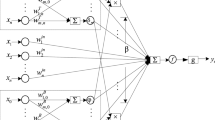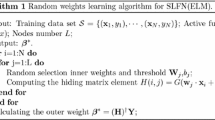Abstract
This paper proposes a novel artificial neural network called Parallel Layer Perceptron Fast Learning Network (PLP-FLN). In PLP-FLN, a parallel single hidden layer feed-forward neural network is added on the basis of Fast Learning Network (FLN) which is an improved Extreme Learning Machine (ELM). Input weights and hidden layer biases are randomly generated. The weights connect the output nodes and the input nodes, and the weights connect the output nodes and the hidden nodes are analytically determined based on least squares methods. In order to test the PLP-FLN validity, this paper compared it with ELM, FLN, Kernel ELM and Incremental ELM through 12 regression applications and 7 classification problems. By comparing the experimental results, it shows that the PLP-FLN with much more compact networks have demonstrated better approximations, classification performances and generalization ability.



Similar content being viewed by others
References
Green M, Ekelund U, Edenbrandt L et al (2009) Exploring new possibilities for case-based explanation of artificial neural network ensembles. Neural Netw 22:75–81
May RJ, Maier HR, Dandy GC (2010) Data splitting for artificial neural networks using SOM-based stratified sampling. Neural Netw Off J Int Neural Netw Soc 23:283–294
Huang GB, Zhu QY, Siew CK (2006) Extreme learning machine: theory and applications. Neurocomputing 70:489–501
Bin LI, Yi-Bin LI (2011) Chaotic time series prediction based on ELM learning algorithm. Tianjin Daxue Xuebao 44:701–704
Huang GB, Siew CK (2005) Extreme learning machine with randomly assigned RBF kernels. Int J Inf Technol 11:16–24
Li MB, Meng JE (2006) Nonlinear system identification using extreme learning machine. Control, automation, robotics and vision, 2006. ICARCV ’06. In: 9th international conference on. IEEE, 1–4
Rong HJ, Huang GB, Sundararajan N et al (2009) Online sequential fuzzy extreme learning machine for function approximation and classification problems. IEEE Trans Syst Man Cybern Part B Cybern A Publ IEEE Syst Man Cybern Soc 39:1067–1072
Han F, Huang DS (2006) Improved extreme learning machine for function approximation by encoding a priori information. Neurocomputing 69:2369–2373
Rong HJ, Ong YS, Tan AH et al (2008) A fast pruned-extreme learning machine for classification problem. Neurocomputing 72:359–366
Suresh S, Babu RV, Kim HJ (2009) No-reference image quality assessment using modified extreme learning machine classifier. Appl Soft Comput 9:541–552
Li G, Niu P (2013) An enhanced extreme learning machine based on ridge regression for regression. Neural Comput Appl 22:803–810
Romero E, Alquézar R (2012) Comparing error minimized extreme learning machines and support vector sequential feed-forward neural networks. Neural Netw 25:122–129
Li G, Niu P, Duan X et al (2013) Fast learning network: a novel artificial neural network with a fast learning speed. Neural Comput Appl 24:1683–1695
Liu X, Wang L, Huang GB et al (2013) Multiple kernel extreme learning machine. Neurocomputing 149:253–264
Huang GB, Li MB, Chen L et al (2008) Incremental extreme learning machine with fully complex hidden nodes[J]. Neurocomputing 71:576–583
Caminhas WM, Vieira DAG, Vasconcelos JA (2003) Parallel layer perceptron. Neurocomputing 55:771–778
Cybenko G (1989) Approximation by superpositions of a sigmoidal function. Math Control Signals Syst 2:303–314
Funahashi KI (1989) On the approximate realization of continuous mappings by neural networks. Neural Netw 2:183–192
Jang JSR (1993) FIS: adaptive-network-based fuzzy inference system. Inst Electr Electron Eng Inc 23:665–685
Hunter D, Wilamowski BM (2011) Parallel multi-layer neural network architecture with improved efficiency. In: The 4th international conference on human system interactions (HSI), Yokohama, Japan, May 19–21, pp 299–304
Gao Z (2013) Parallel and distributed implementation of a multilayer perceptron neural network on a wireless sensor network. Dissertations & Theses—Gradworks
Bhattacharjee D, Basu DK, Kundu M et al (2010) A parallel framework for multilayer perceptron for human face recognition. Int J Comput Sci Secur 3(6):491–507
Sotirov S, Atanassov K, Krawczak M (2010) Generalized net model for parallel optimization of multilayer perceptron with momentum backpropagation algorithm Intelligent Systems. In: IEEE, 281–285
Tavares LD, Saldanha RR, Vieira DAG (2015) Extreme learning machine with parallel layer perceptrons. Neurocomputing 166:164–171
Huang GB, Zhu QY, Siew CK (2004) Extreme learning machine: a new learning scheme of feedforward neural networks. In: Proceedings international joint Conference neural Networks, vol 2. pp 985–990
Karaboga D, Basturk B (2008) On the performance of artificial bee colony (ABC) algorithm. Appl Soft Comput 8:687–697
Li G, Niu P, Xiao X (2012) Development and investigation of efficient artificial bee colony algorithm for numerical function optimization. Appl Soft Comput 12(1):320–332
Li J (2002) Over-fitting in neural network learning algorithms and its solving strategies. Zhendong Ceshi Yu Zhenduan/J Vib Meas Diagn 22:260–264
Kohavi R (1995) A study of cross-validation and bootstrap for accuracy estimation and model selection. In: Proceedings of the 14th international joint conference on Artificial intelligence, vol 2. San Francisco, USA, pp 1137–1143
Tianyun LI, Chen C, Cheng W et al (2007) Application of cross validation in power quality de-noising. Autom Electr Power Syst 31:75–78
Liang N-Y, Huang G-B, Saratchandran P, Sundararajan N (2006) A fast and accurate online sequential learning algorithm for feedforward networks. IEEE Trans Neural Netw 17:1411–1423
Lan Y, Soh YC, Huang G-B (2010) Two-stage extreme learning machine for regression. Neurocomputing 73:3028–3038
Acknowledgements
Project supported by the National Natural Science Foundation of China (Grant No. 61403331,61573306), Program for the Top Young Talents of Higher Learning Institutions of Hebei (Grant No. BJ2017033), Natural Science Foundation of Hebei Province (Grant No. F2016203427), China Postdoctoral Science Foundation (Grant No. 2015M571280), the Doctorial Foundation of Yanshan University (Grant No.B847), the natural science foundation for young scientist of Hebei province (Grant No.F2014203099) and the independent research program for young teachers of yanshan university (Grant No. 13LG006).
Author information
Authors and Affiliations
Corresponding author
Rights and permissions
About this article
Cite this article
Li, G., Qi, X., Chen, B. et al. Fast Learning Network with Parallel Layer Perceptrons. Neural Process Lett 47, 549–564 (2018). https://doi.org/10.1007/s11063-017-9667-6
Published:
Issue Date:
DOI: https://doi.org/10.1007/s11063-017-9667-6




